Lesson 10: The Power of Algebra—Finding
advertisement
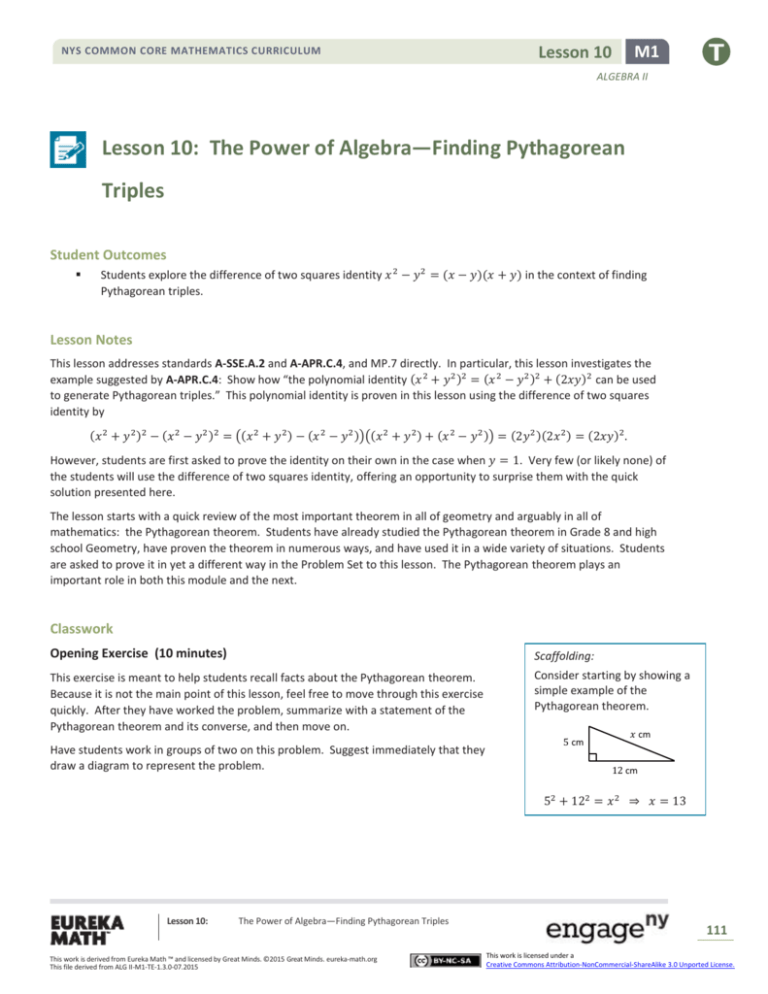
NYS COMMON CORE MATHEMATICS CURRICULUM
M1
Lesson 10
ALGEBRA II
Lesson 10: The Power of Algebra—Finding Pythagorean
Triples
Student Outcomes
Students explore the difference of two squares identity 𝑥 2 − 𝑦 2 = (𝑥 − 𝑦)(𝑥 + 𝑦) in the context of finding
Pythagorean triples.
Lesson Notes
This lesson addresses standards A-SSE.A.2 and A-APR.C.4, and MP.7 directly. In particular, this lesson investigates the
example suggested by A-APR.C.4: Show how “the polynomial identity (𝑥 2 + 𝑦 2 )2 = (𝑥 2 − 𝑦 2 )2 + (2𝑥𝑦)2 can be used
to generate Pythagorean triples.” This polynomial identity is proven in this lesson using the difference of two squares
identity by
(𝑥 2 + 𝑦 2 )2 − (𝑥 2 − 𝑦 2 )2 = ((𝑥 2 + 𝑦 2 ) − (𝑥 2 − 𝑦 2 ))((𝑥 2 + 𝑦 2 ) + (𝑥 2 − 𝑦 2 )) = (2𝑦 2 )(2𝑥 2 ) = (2𝑥𝑦)2 .
However, students are first asked to prove the identity on their own in the case when 𝑦 = 1. Very few (or likely none) of
the students will use the difference of two squares identity, offering an opportunity to surprise them with the quick
solution presented here.
The lesson starts with a quick review of the most important theorem in all of geometry and arguably in all of
mathematics: the Pythagorean theorem. Students have already studied the Pythagorean theorem in Grade 8 and high
school Geometry, have proven the theorem in numerous ways, and have used it in a wide variety of situations. Students
are asked to prove it in yet a different way in the Problem Set to this lesson. The Pythagorean theorem plays an
important role in both this module and the next.
Classwork
Opening Exercise (10 minutes)
Scaffolding:
This exercise is meant to help students recall facts about the Pythagorean theorem.
Because it is not the main point of this lesson, feel free to move through this exercise
quickly. After they have worked the problem, summarize with a statement of the
Pythagorean theorem and its converse, and then move on.
Consider starting by showing a
simple example of the
Pythagorean theorem.
Have students work in groups of two on this problem. Suggest immediately that they
draw a diagram to represent the problem.
5 cm
𝑥 cm
12 cm
52 + 122 = 𝑥 2 ⇒ 𝑥 = 13
Lesson 10:
The Power of Algebra—Finding Pythagorean Triples
This work is derived from Eureka Math ™ and licensed by Great Minds. ©2015 Great Minds. eureka-math.org
This file derived from ALG II-M1-TE-1.3.0-07.2015
111
This work is licensed under a
Creative Commons Attribution-NonCommercial-ShareAlike 3.0 Unported License.
Lesson 10
NYS COMMON CORE MATHEMATICS CURRICULUM
M1
ALGEBRA II
Opening Exercise
Sam and Jill decide to explore a city. Both begin their walk from the same starting point.
Sam walks 𝟏 block north, 𝟏 block east, 𝟑 blocks north, and 𝟑 blocks west.
Jill walks 𝟒 blocks south, 𝟏 block west, 𝟏 block north, and 𝟒 blocks east.
If all city blocks are the same length, who is the farthest distance from the starting point?
Sam’s distance: √𝟐𝟎 city block lengths
Jill’s distance: √𝟏𝟖 city block lengths
Sam was farthest away from the starting point.
Students may have a question about what the problem is asking: Does distance mean, “Who walked the farthest?”, or
“Who is the farthest (as the crow flies) from the starting point?” This question boils down to the difference between the
definitions of path length versus distance. While Sam’s path length is 8 city blocks and Jill’s is 10 city blocks, the
question asks for the distance between the starting point and their final destinations. To calculate distance, students
need to use the Pythagorean theorem.
The problem is designed so that answers cannot be guessed easily from precisely drawn pictures.
Another (valid) issue that a student may bring up is whether the streets are considered to have width or not. Discuss this
possibility with the class (again, it is a valid point). Suggest that for the purposes of this problem, the assumption is that
the streets have no width (or, as some may point out, Sam and Jill could walk down the center of the streets—but this is
not advisable).
Try to get students to conclude that √18 < √20 simply because 18 < 20 and the square root function increases.
Why must the side length of a square with area 18 square units be smaller than the side length of a square
with area 20 square units?
Can you state the Pythagorean theorem?
MP.6
What is the converse of the Pythagorean theorem? Can you state it as an if–then statement?
If a right triangle has legs of length 𝑎 and 𝑏 units and a hypotenuse of length 𝑐 units,
then 𝑎2 + 𝑏 2 = 𝑐 2 .
If the lengths 𝑎, 𝑏, 𝑐 of the sides of a triangle are related by 𝑎2 + 𝑏 2 = 𝑐 2 , then the angle opposite the
side of length 𝑐 is a right angle.
We will need the converse of the Pythagorean theorem for this lesson.
Lesson 10:
The Power of Algebra—Finding Pythagorean Triples
This work is derived from Eureka Math ™ and licensed by Great Minds. ©2015 Great Minds. eureka-math.org
This file derived from ALG II-M1-TE-1.3.0-07.2015
112
This work is licensed under a
Creative Commons Attribution-NonCommercial-ShareAlike 3.0 Unported License.
Lesson 10
NYS COMMON CORE MATHEMATICS CURRICULUM
M1
ALGEBRA II
Example 1 (15 minutes)
Scaffolding:
In this example, students explore a specific case of the general method of generating
Pythagorean triples, that is triples of positive integers (𝑎, 𝑏, 𝑐) that satisfy 𝑎2 + 𝑏 2 = 𝑐 2 .
The general form that students explore in the Problem Set is (𝑥 2 − 𝑦 2 , 2𝑥𝑦, 𝑥 2 − 𝑦 2 ) for
𝑥 > 𝑦.
Example 1
MP.3
Prove that if 𝒙 > 𝟏, then a triangle with side lengths 𝒙𝟐 − 𝟏, 𝟐𝒙, and 𝒙𝟐 + 𝟏 is a right triangle.
To make this example more
concrete and accessible,
generate (or ask students to
generate) a set of triples of the
form (𝑥 2 − 𝑦 2 , 2𝑥𝑦, 𝑥 2 + 𝑦 2 )
and verify that they are
Pythagorean triples. For
example, (3,4,5) arises when
𝑥 = 2 and 𝑦 = 1.
Furthermore, consider
challenging them to find a
triple of this form that is not a
Pythagorean triple.
If 𝒙 > 𝟏, is this
triangle right?
Note: By the converse to the Pythagorean theorem, if 𝒂𝟐 + 𝒃𝟐 = 𝒄𝟐 , then a triangle with side lengths 𝒂, 𝒃, 𝒄 is a right
triangle with a right angle opposite the side of length 𝒄. We are given that the triangle exists with these side lengths, so
we do not need to explicitly verify that the lengths are positive. Therefore, we need only check that for any 𝒙 > 𝟏, we
have (𝒙𝟐 − 𝟏)𝟐 + (𝟐𝒙)𝟐 = (𝒙𝟐 + 𝟏)𝟐.
PROOF: We are given a triangle with side lengths 𝟐𝒙, 𝒙𝟐 − 𝟏, and 𝒙𝟐 + 𝟏 for some real number 𝒙 > 𝟏. We need to show
that the three lengths 𝟐𝒙, 𝒙𝟐 − 𝟏, and 𝒙𝟐 + 𝟏 form a Pythagorean triple. We will first show that (𝟐𝒙)𝟐 is equivalent to
(𝒙𝟐 + 𝟏)𝟐 − (𝒙𝟐 − 𝟏)𝟐 .
(𝒙𝟐 + 𝟏)𝟐 − (𝒙𝟐 − 𝟏)𝟐 = ((𝒙𝟐 + 𝟏) + (𝒙𝟐 − 𝟏))((𝒙𝟐 + 𝟏) − (𝒙𝟐 − 𝟏))
= (𝟐𝒙𝟐 )(𝟐)
= 𝟒𝒙𝟐
= (𝟐𝒙)𝟐
MP.7
Since (𝟐𝒙)𝟐 = (𝒙𝟐 + 𝟏)𝟐 − (𝒙𝟐 − 𝟏)𝟐 , we have shown that (𝒙𝟐 − 𝟏)𝟐 + (𝟐𝒙)𝟐 = (𝒙𝟐 + 𝟏)𝟐 , and thus the numbers 𝒙𝟐 −
𝟏, 𝟐𝒙, and 𝒙𝟐 + 𝟏 form a Pythagorean triple. Then by the converse of the Pythagorean theorem, a triangle with sides of
length 𝟐𝒙, 𝒙𝟐 − 𝟏, and 𝒙𝟐 + 𝟏 for some 𝒙 > 𝟏 is a right triangle.
Proving that (𝑥 2 − 1)2 + (2𝑥)2 = (𝑥 2 + 1)2 can be done in different ways. Consider asking students to try their own
method first, and then show the method above. Very few students will use the identity 𝑎2 − 𝑏 2 = (𝑎 − 𝑏)(𝑎 + 𝑏).
Most will use (𝑥 2 − 1)2 + 4𝑥 2 = 𝑥 4 − 2𝑥 2 + 1 + 4𝑥 2 = 𝑥 4 + 2𝑥 2 + 1 = (𝑥 2 + 1)2 . This is an excellent exercise as
well, since it gets students to wrestle with squares of quadratic polynomials and requires factoring. After they have tried
it on their own, they will be surprised by the use of the difference of squares identity.
A Pythagorean triple is a triple of positive integers (𝑎, 𝑏, 𝑐) such that 𝑎2 + 𝑏 2 = 𝑐 2 . So, while (3, 4, 5) is a
Pythagorean triple, the triple (1, 1, √2) is not, even though 1, 1, and √2 are side lengths of a 45°-45°-90°
2
triangle and 12 + 12 = (√2) . While the triangle from Example 1 can have non-integer side lengths, notice that
a Pythagorean triple must comprise positive integers by definition.
Note that any multiple of a Pythagorean triple is also a Pythagorean triple: if (𝑎, 𝑏, 𝑐) is a Pythagorean triple,
then so is (𝑛𝑎, 𝑛𝑏, 𝑛𝑐) for any positive integer 𝑛 (discuss why). Thus, (6, 8, 10), (9, 12, 15), (12, 16, 20),
(15, 20, 25) are all Pythagorean triples because they are multiples of (3, 4, 5).
Lesson 10:
The Power of Algebra—Finding Pythagorean Triples
This work is derived from Eureka Math ™ and licensed by Great Minds. ©2015 Great Minds. eureka-math.org
This file derived from ALG II-M1-TE-1.3.0-07.2015
113
This work is licensed under a
Creative Commons Attribution-NonCommercial-ShareAlike 3.0 Unported License.
Lesson 10
NYS COMMON CORE MATHEMATICS CURRICULUM
M1
ALGEBRA II
Also note that if (𝑎, 𝑏, 𝑐) is a Pythagorean triple, then (𝑏, 𝑎, 𝑐) is also a Pythagorean triple. To reduce
redundancy, we often write the smaller number of 𝑎 and 𝑏 first. Although (3, 4, 5) and (4, 3, 5) are both
Pythagorean triples, they represent the same triple, and we refer to it as (3, 4, 5).
One way to generate Pythagorean triples is to use the expressions from Example 1: (𝑥 2 − 1, 2𝑥, 𝑥 2 + 1).
Have students try a few as mental math exercises: 𝑥 = 2 gives (4, 3, 5), 𝑥 = 3 gives (8, 6, 10), 𝑥 = 4 gives (15, 8, 17),
and so on.
One of the Problem Set questions asks students to generalize triples from (𝑥 2 − 1, 2𝑥, 𝑥 2 + 1) to show that triples
generated by (𝑥 2 − 𝑦 2 , 2𝑥𝑦, 𝑥 2 + 𝑦 2 ) also form Pythagorean triples for 𝑥 > 𝑦 > 0. The next example helps students
see the general pattern.
Example 2 (12 minutes)
This example shows a clever way for students to remember that 𝑥 2 − 1, 2𝑥, and 𝑥 2 + 1 can be used to find Pythagorean
triples.
Example 2
Next we describe an easy way to find Pythagorean triples using the expressions from Example 1. Look at the
multiplication table below for {𝟏, 𝟐, … , 𝟗}. Notice that the square numbers {𝟏, 𝟒, 𝟗, … , 𝟖𝟏} lie on the diagonal of this
table.
a.
What value of 𝒙 is used to generate the Pythagorean triple (𝟏𝟓, 𝟖, 𝟏𝟕) by the formula (𝒙𝟐 − 𝟏, 𝟐𝒙, 𝒙𝟐 + 𝟏)?
How do the numbers (𝟏, 𝟒, 𝟒, 𝟏𝟔) at the corners of the shaded square in the table relate to the values 𝟏𝟓, 𝟖,
and 𝟏𝟕?
Using the value 𝟒 for 𝒙 gives the triple (𝟏𝟓, 𝟖, 𝟏𝟕). We see that
𝟏 = 𝟏𝟐 and 𝟏𝟔 = 𝟒𝟐 , and then we can take 𝟏𝟔 − 𝟏 = 𝟏𝟓, and
𝟏𝟔 + 𝟏 = 𝟏𝟕. We also have 𝟒 + 𝟒 = 𝟖.
b.
Now you try one. Form a square on the multiplication table below whose left-top corner is the 𝟏 (as in the
example above) and whose bottom-right corner is a square number. Use the sums or differences of the
numbers at the vertices of your square to form a Pythagorean triple. Check that the triple you generate is a
Pythagorean triple.
Answers will vary. Ask students to report their answers. For
example, a student whose square has the bottom-right number 𝟑𝟔
will generate 𝟑𝟔 − 𝟏 = 𝟑𝟓, 𝟔 + 𝟔 = 𝟏𝟐, and 𝟑𝟔 + 𝟏 = 𝟑𝟕. Have
students check that (𝟏𝟐, 𝟑𝟓, 𝟑𝟕) is indeed a Pythagorean triple:
𝟏𝟐𝟐 + 𝟑𝟓𝟐 = 𝟏𝟑𝟔𝟗, and 𝟑𝟔𝟐 = 𝟏𝟑𝟔𝟗.
Lesson 10:
The Power of Algebra—Finding Pythagorean Triples
This work is derived from Eureka Math ™ and licensed by Great Minds. ©2015 Great Minds. eureka-math.org
This file derived from ALG II-M1-TE-1.3.0-07.2015
114
This work is licensed under a
Creative Commons Attribution-NonCommercial-ShareAlike 3.0 Unported License.
Lesson 10
NYS COMMON CORE MATHEMATICS CURRICULUM
M1
ALGEBRA II
Let’s generalize this square to any square in the multiplication table where two opposite vertices of the square are square
numbers.
c.
How can you use the sums or differences of the numbers at the vertices of the shaded square to get a triple
(𝟏𝟔, 𝟑𝟎, 𝟑𝟒)? Is it a Pythagorean triple?
Following what we did above, take 𝟐𝟓 − 𝟗 = 𝟏𝟔, 𝟏𝟓 + 𝟏𝟓 = 𝟑𝟎,
and 𝟐𝟓 + 𝟗 = 𝟑𝟒 to get the triple (𝟏𝟔, 𝟑𝟎, 𝟑𝟒). Yes, it is a
Pythagorean triple: 𝟏𝟔𝟐 + 𝟑𝟎𝟐 = 𝟗𝟎𝟎 + 𝟐𝟓𝟔 = 𝟏𝟏𝟓𝟔 = 𝟑𝟒𝟐 .
d.
Using 𝒙 instead of 𝟓 and 𝒚 instead of 𝟑 in your calculations in part (c), write down a formula for generating
Pythagorean triples in terms of 𝒙 and 𝒚.
The calculation 𝟐𝟓 − 𝟗 generalizes to 𝒙𝟐 − 𝒚𝟐 as the length of one leg. The length of the other leg can be
found by 𝟏𝟓 + 𝟏𝟓 = 𝟐(𝟑 ∙ 𝟓), which generalizes to 𝟐𝒙𝒚. The length of the hypotenuse, 𝟐𝟓 + 𝟗, generalizes to
𝒙𝟐 + 𝒚𝟐 . It seems that Pythagorean triples can be generated by triples (𝒙𝟐 − 𝒚𝟐 , 𝟐𝒙𝒚, 𝒙𝟐 + 𝒚𝟐 ) where
𝒙 > 𝒚 > 𝟎.
In the Problem Set, students prove that if 𝑥 and 𝑦 are positive integers with 𝑥 > 𝑦, then (𝑥 2 − 𝑦 2 , 2𝑥𝑦, 𝑥 2 + 𝑦 2 ) is a
Pythagorean triple, mimicking the proof of Example 1.
Closing (3 minutes)
Pythagorean triples are triples of positive integers (𝑎, 𝑏, 𝑐) that satisfy the relationship 𝑎2 + 𝑏 2 = 𝑐 2 . Such a
triple is called a Pythagorean triple because a right triangle with legs of length 𝑎 and 𝑏 will have a hypotenuse
of length 𝑐 by the Pythagorean theorem.
To generate a Pythagorean triple, take any two positive integers 𝑥 and 𝑦 with 𝑥 > 𝑦, and compute
(𝑥 2 − 𝑦 2 , 2𝑥𝑦, 𝑥 2 + 𝑦 2 ).
Relevant Facts and Vocabulary
PYTHAGOREAN THEOREM: If a right triangle has legs of length 𝒂 and 𝒃 units and hypotenuse of length 𝒄 units, then
𝒂 𝟐 + 𝒃 𝟐 = 𝒄𝟐 .
CONVERSE TO THE PYTHAGOREAN THEOREM: If the lengths 𝒂, 𝒃, 𝒄 of the sides of a triangle are related by 𝒂𝟐 + 𝒃𝟐 = 𝒄𝟐 , then
the angle opposite the side of length 𝒄 is a right angle.
PYTHAGOREAN TRIPLE: A Pythagorean triple is a triple of positive integers (𝒂, 𝒃, 𝒄) such that 𝒂𝟐 + 𝒃𝟐 = 𝒄𝟐. The triple
(𝟑, 𝟒, 𝟓) is a Pythagorean triple but (𝟏, 𝟏, √𝟐) is not, even though the numbers are side lengths of an isosceles right
triangle.
Exit Ticket (5 minutes)
Lesson 10:
The Power of Algebra—Finding Pythagorean Triples
This work is derived from Eureka Math ™ and licensed by Great Minds. ©2015 Great Minds. eureka-math.org
This file derived from ALG II-M1-TE-1.3.0-07.2015
115
This work is licensed under a
Creative Commons Attribution-NonCommercial-ShareAlike 3.0 Unported License.
Lesson 10
NYS COMMON CORE MATHEMATICS CURRICULUM
M1
ALGEBRA II
Name
Date
Lesson 10: The Power of Algebra—Finding Pythagorean Triples
Exit Ticket
Generate six Pythagorean triples using any method discussed during class. Explain each method you use.
Lesson 10:
The Power of Algebra—Finding Pythagorean Triples
This work is derived from Eureka Math ™ and licensed by Great Minds. ©2015 Great Minds. eureka-math.org
This file derived from ALG II-M1-TE-1.3.0-07.2015
116
This work is licensed under a
Creative Commons Attribution-NonCommercial-ShareAlike 3.0 Unported License.
Lesson 10
NYS COMMON CORE MATHEMATICS CURRICULUM
M1
ALGEBRA II
Exit Ticket Sample Solutions
Generate six Pythagorean triples using any method discussed during class. Explain each method you use.
Answers will vary. One example should use either (𝒙𝟐 − 𝟏, 𝟐𝒙, 𝒙𝟐 + 𝟏) or (𝒙𝟐 − 𝒚𝟐 , 𝟐𝒙𝒚, 𝒙𝟐 + 𝒚𝟐 ), but after that students
can use the fact that a multiple of a Pythagorean triple is again a Pythagorean triple.
Problem Set Sample Solutions
1.
Rewrite each expression as a sum or difference of terms.
a.
(𝒙 − 𝟑)(𝒙 + 𝟑)
b.
𝒙𝟐 − 𝟗
c.
𝒙𝟒 − 𝟗
(𝒙𝟏𝟓 + 𝟑)(𝒙𝟏𝟓 − 𝟑)
d.
(𝒙𝟐 + 𝒚𝟐 )(𝒙𝟐 − 𝒚𝟐 )
f.
𝒙𝟒 − 𝒚𝟒
g.
(𝒙𝟐 + 𝒚𝟐 )𝟐
𝒙𝟒 + 𝟐𝒙𝟐 𝒚𝟐 + 𝒚𝟒
(𝒙 − 𝒚)𝟐 (𝒙 + 𝒚)𝟐
h.
𝒙𝟒 − 𝟐𝒙𝟐 𝒚𝟐 + 𝒚𝟒
2.
(𝒙 − 𝟑)(𝒙𝟐 + 𝟗)(𝒙 + 𝟑)
𝒙𝟒 − 𝟖𝟏
𝒙𝟑𝟎 − 𝟗
e.
(𝒙𝟐 − 𝟑)(𝒙𝟐 + 𝟑)
(𝒙 − 𝒚)𝟐 (𝒙𝟐 + 𝒚𝟐 )𝟐 (𝒙 + 𝒚)𝟐
𝒙𝟖 − 𝟐𝒙𝟒 𝒚𝟒 + 𝒚𝟖
Tasha used a clever method to expand (𝒂 + 𝒃 + 𝒄)(𝒂 + 𝒃 − 𝒄). She grouped the addends together like this
[(𝒂 + 𝒃) + 𝒄][(𝒂 + 𝒃) − 𝒄] and then expanded them to get the difference of two squares:
(𝒂 + 𝒃 + 𝒄)(𝒂 + 𝒃 − 𝒄) = [(𝒂 + 𝒃) + 𝒄][(𝒂 + 𝒃) − 𝒄] = (𝒂 + 𝒃)𝟐 − 𝒄𝟐 = 𝒂𝟐 + 𝟐𝒂𝒃 + 𝒃𝟐 − 𝒄𝟐 .
a.
Is Tasha's method correct? Explain why or why not.
Yes, Tasha is correct. Expanding in the traditional way gives the same result.
(𝒂 + 𝒃 + 𝒄)(𝒂 + 𝒃 − 𝒄) = (𝒂 + 𝒃 + 𝒄)𝒂 + (𝒂 + 𝒃 + 𝒄)𝒃 − (𝒂 + 𝒃 + 𝒄)𝒄
= 𝒂𝟐 + 𝒃𝒂 + 𝒄𝒂 + 𝒂𝒃 + 𝒃𝟐 + 𝒄𝒃 − 𝒂𝒄 − 𝒃𝒄 − 𝒄𝟐
= 𝒂𝟐 + 𝟐𝒂𝒃 + 𝒃𝟐 − 𝒄𝟐
b.
Use a version of her method to find (𝒂 + 𝒃 + 𝒄)(𝒂 − 𝒃 − 𝒄).
(𝒂 + (𝒃 + 𝒄))(𝒂 − (𝒃 + 𝒄)) = 𝒂𝟐 − (𝒃 + 𝒄)𝟐 = 𝒂𝟐 − 𝒃𝟐 − 𝟐𝒃𝒄 − 𝒄𝟐
c.
Use a version of her method to find (𝒂 + 𝒃 − 𝒄)(𝒂 − 𝒃 + 𝒄).
(𝒂 + (𝒃 − 𝒄))(𝒂 − (𝒃 − 𝒄)) = 𝒂𝟐 − (𝒃 − 𝒄)𝟐 = 𝒂𝟐 − 𝒃𝟐 + 𝟐𝒃𝒄 − 𝒄𝟐
3.
Use the difference of two squares identity to factor each of the following expressions.
a.
𝒙𝟐 − 𝟖𝟏
b.
(𝟑𝒙 − 𝒚)(𝟑𝒙 + 𝟑𝒚) = 𝟑(𝟑𝒙 − 𝒚)(𝒙 + 𝒚)
(𝒙 − 𝟗)(𝒙 + 𝟗)
c.
𝟒 − (𝒙 − 𝟏)𝟐
d.
(𝟑 − 𝒙)(𝟏 + 𝒙)
Lesson 10:
(𝟑𝒙 + 𝒚)𝟐 − (𝟐𝒚)𝟐
(𝒙 + 𝟐)𝟐 − (𝒚 + 𝟐)𝟐
(𝒙 − 𝒚)(𝒙 + 𝒚 + 𝟒)
The Power of Algebra—Finding Pythagorean Triples
This work is derived from Eureka Math ™ and licensed by Great Minds. ©2015 Great Minds. eureka-math.org
This file derived from ALG II-M1-TE-1.3.0-07.2015
117
This work is licensed under a
Creative Commons Attribution-NonCommercial-ShareAlike 3.0 Unported License.
Lesson 10
NYS COMMON CORE MATHEMATICS CURRICULUM
M1
ALGEBRA II
4.
Show that the expression (𝒙 + 𝒚)(𝒙 − 𝒚) − 𝟔𝒙 + 𝟗 may be written as the difference of two squares, and then factor
the expression.
(𝒙 + 𝒚)(𝒙 − 𝒚) − 𝟔𝒙 + 𝟗 = 𝒙𝟐 − 𝒚𝟐 − 𝟔𝒙 + 𝟗 = (𝒙𝟐 − 𝟔𝒙 + 𝟗) − 𝒚𝟐 = (𝒙 − 𝟑)𝟐 − 𝒚𝟐 = (𝒙 − 𝟑 − 𝒚)(𝒙 − 𝟑 + 𝒚)
5.
Show that (𝒙 + 𝒚)𝟐 − (𝒙 − 𝒚)𝟐 = 𝟒𝒙𝒚 for all real numbers 𝒙 and 𝒚.
(𝒙 + 𝒚)𝟐 − (𝒙 − 𝒚)𝟐 = [(𝒙 + 𝒚) − (𝒙 − 𝒚)][(𝒙 + 𝒚) + (𝒙 − 𝒚)] = (𝟐𝒚)(𝟐𝒙) = 𝟒𝒙
6.
Prove that a triangle with side lengths 𝒙𝟐 − 𝒚𝟐 , 𝟐𝒙𝒚, and 𝒙𝟐 + 𝒚𝟐 with 𝒙 > 𝒚 > 𝟎 is a right triangle.
The proof should look like the proof in Example 1 but with 𝒚 instead of 𝟏.
7.
8.
Complete the table below to find Pythagorean triples (the first row is done for you).
𝒙
𝒚
𝒙𝟐 − 𝒚𝟐
𝟐𝒙𝒚
𝒙𝟐 + 𝒚𝟐
Check: Is it a Pythagorean Triple?
𝟐
𝟏
𝟑
𝟒
𝟓
Yes: 𝟑𝟐 + 𝟒𝟐 = 𝟐𝟓 = 𝟓𝟐
𝟑
𝟏
𝟖
𝟔
𝟏𝟎
Yes: 𝟖𝟐 + 𝟔𝟐 = 𝟏𝟎𝟎 = 𝟏𝟎𝟐
𝟑
𝟐
𝟓
𝟏𝟐
𝟏𝟑
Yes: 𝟓𝟐 + 𝟏𝟐𝟐 = 𝟏𝟔𝟗 = 𝟏𝟑𝟐
𝟒
𝟏
𝟏𝟓
𝟖
𝟏𝟕
Yes: 𝟏𝟓𝟐 + 𝟖𝟐 = 𝟐𝟖𝟗 = 𝟏𝟕𝟐
𝟒
𝟐
𝟏𝟐
𝟏𝟔
𝟐𝟎
Yes: 𝟏𝟐𝟐 + 𝟏𝟔𝟐 = 𝟒𝟎𝟎 = 𝟐𝟎𝟐
𝟒
𝟑
𝟕
𝟐𝟒
𝟐𝟓
Yes: 𝟕𝟐 + 𝟐𝟒𝟐 = 𝟔𝟐𝟓 = 𝟐𝟓𝟐
𝟓
𝟏
𝟐𝟒
𝟏𝟎
𝟐𝟔
Yes: 𝟐𝟒𝟐 + 𝟏𝟎𝟐 = 𝟔𝟕𝟔 = 𝟐𝟔𝟐
Answer the following parts about the triple (𝟗, 𝟏𝟐, 𝟏𝟓).
a.
Show that (𝟗, 𝟏𝟐, 𝟏𝟓) is a Pythagorean triple.
We see that 𝟗𝟐 + 𝟏𝟐𝟐 = 𝟖𝟏 + 𝟏𝟒𝟒 = 𝟐𝟐𝟓, and 𝟏𝟓𝟐 = 𝟐𝟐𝟓 so 𝟗𝟐 + 𝟏𝟐𝟐 = 𝟏𝟓𝟐 .
b.
Prove that neither (𝟗, 𝟏𝟐, 𝟏𝟓) nor (𝟏𝟐, 𝟗, 𝟏𝟓) can be found by choosing a pair of integers 𝒙 and 𝒚 with 𝒙 > 𝒚
and computing (𝒙𝟐 − 𝒚𝟐 , 𝟐𝒙𝒚, 𝒙𝟐 + 𝒚𝟐 ).
(Hint: What are the possible values of 𝒙 and 𝒚 if 𝟐𝒙𝒚 = 𝟏𝟐? What about if 𝟐𝒙𝒚 = 𝟗?)
PROOF: Since 𝟗 is odd and 𝟐𝒙𝒚 is even, there are no integer values of 𝒙 and 𝒚 that satisfy 𝟐𝒙𝒚 = 𝟗. Thus, our
formula cannot generate the triple (𝟏𝟐, 𝟗, 𝟏𝟓). Now suppose 𝒙 and 𝒚 are integers such that 𝟐𝒙𝒚 = 𝟏𝟐. Thus
𝒙𝒚 = 𝟔 and 𝒙 > 𝒚. There are only two possibilities: either 𝒙 = 𝟔 and 𝒚 = 𝟏, or 𝒙 = 𝟑 and 𝒚 = 𝟐. In the first
case, our formula generates the triple (𝟔𝟐 − 𝟏, 𝟐 ∙ 𝟔 ∙ 𝟏, 𝟔𝟐 + 𝟏) = (𝟑𝟓, 𝟏𝟐, 𝟑𝟕). In the second case, our
formula generates the triple (𝟑𝟐 − 𝟐𝟐 , 𝟐 ∙ 𝟑 ∙ 𝟐, 𝟑𝟐 + 𝟐𝟐 ) = (𝟓, 𝟏𝟐, 𝟏𝟑). Thus, there is no way to generate the
triple (𝟗, 𝟏𝟐, 𝟏𝟓) using this method, even though it is a Pythagorean triple.
c.
Wouldn’t it be nice if all Pythagorean triples were generated by (𝒙𝟐 − 𝒚𝟐 , 𝟐𝒙𝒚, 𝒙𝟐 + 𝒚𝟐 )? Research
Pythagorean triples on the Internet to discover what is known to be true about generating all Pythagorean
triples using this formula.
All Pythagorean triples are some multiple of a Pythagorean triple generated using this formula. For example,
while (𝟗, 𝟏𝟐, 𝟏𝟓) is not generated by the formula, it is a multiple of a Pythagorean triple (𝟑, 𝟒, 𝟓), which is
generated by the formula.
9.
Follow the steps below to prove the identity (𝒂𝟐 + 𝒃𝟐 )(𝒙𝟐 + 𝒚𝟐 ) = (𝒂𝒙 − 𝒃𝒚)𝟐 + (𝒃𝒙 + 𝒂𝒚)𝟐.
a.
Multiply (𝒂𝟐 + 𝒃𝟐 )(𝒙𝟐 + 𝒚𝟐 ).
(𝒂𝟐 + 𝒃𝟐 )(𝒙𝟐 + 𝒚𝟐 ) = 𝒂𝟐 𝒙𝟐 + 𝒂𝟐 𝒚𝟐 + 𝒃𝟐 𝒙𝟐 + 𝒃𝟐 𝒚𝟐
Lesson 10:
The Power of Algebra—Finding Pythagorean Triples
This work is derived from Eureka Math ™ and licensed by Great Minds. ©2015 Great Minds. eureka-math.org
This file derived from ALG II-M1-TE-1.3.0-07.2015
118
This work is licensed under a
Creative Commons Attribution-NonCommercial-ShareAlike 3.0 Unported License.
Lesson 10
NYS COMMON CORE MATHEMATICS CURRICULUM
M1
ALGEBRA II
b.
Square both binomials in (𝒂𝒙 − 𝒃𝒚)𝟐 + (𝒃𝒙 + 𝒂𝒚)𝟐 and collect like terms.
(𝒂𝒙 − 𝒃𝒚)𝟐 + (𝒃𝒙 + 𝒂𝒚)𝟐 = 𝒂𝟐 𝒙𝟐 − 𝟐𝒂𝒙𝒃𝒚 + 𝒃𝟐 𝒚𝟐 + 𝒃𝟐 𝒙𝟐 + 𝟐𝒂𝒙𝒃𝒚 + 𝒂𝟐 𝒚𝟐
= 𝒂𝟐 𝒙𝟐 + 𝒂𝟐 𝒚𝟐 + 𝒃𝟐 𝒙𝟐 + 𝒃𝟐 𝒚𝟐
c.
Use your answers from part (a) and part (b) to prove the identity.
(𝒂𝟐 + 𝒃𝟐 )(𝒙𝟐 + 𝒚𝟐 ) = 𝒂𝟐 𝒙𝟐 + 𝒂𝟐 𝒚𝟐 + 𝒃𝟐 𝒙𝟐 + 𝒃𝟐 𝒚𝟐
= (𝒂𝒙 − 𝒃𝒚)𝟐 + (𝒃𝒙 + 𝒂𝒚)𝟐
10. Many U.S. presidents took great delight in studying mathematics. For example,
President James Garfield, while still a congressman, came up with a proof of the
Pythagorean theorem based upon the ideas presented below.
In the diagram, two congruent right triangles with side lengths 𝒂, 𝒃, and
hypotenuse 𝒄, are used to form a trapezoid 𝑷𝑸𝑹𝑺 composed of three triangles.
a.
Explain why ∠𝑸𝑻𝑹 is a right angle.
Since ∠𝑻𝑺𝑹 is a right angle, the measures of ∠𝑺𝑻𝑹 and ∠𝑺𝑹𝑻 sum to 𝟗𝟎°, so
∠𝑺𝑻𝑹 and ∠𝑺𝑹𝑻 are complementary angles. Since △ 𝑻𝑺𝑹 ≅ △ 𝑸𝑷𝑻 by SSS
triangle congruence, we have ∠𝑺𝑹𝑻 ≅ ∠𝑷𝑻𝑸. Thus, ∠𝑷𝑻𝑸 and ∠𝑺𝑻𝑹 must
also be complementary. By the angle sum properties,
𝒎∠𝑸𝑻𝑹 + ⏟
𝒎∠𝑷𝑻𝑸 + 𝒎∠𝑺𝑻𝑹 = 𝟏𝟖𝟎°
𝟗𝟎°
so that
𝒎∠𝑸𝑻𝑹 + 𝟗𝟎° = 𝟏𝟖𝟎°
and we have shown that 𝒎∠𝑸𝑻𝑹 = 𝟗𝟎°. Thus, ∠𝑸𝑻𝑹 is a right angle.
b.
What are the areas of △ 𝑺𝑻𝑹, △ 𝑷𝑻𝑸, and △ 𝑸𝑻𝑹 in terms of 𝒂, 𝒃, and 𝒄?
𝟏
𝟐
𝟏
𝟐
𝟏
𝟐
We see that 𝑨(△ 𝑺𝑻𝑹) = 𝒂𝒃, 𝑨(△ 𝑷𝑻𝑸) = 𝒂𝒃, and because ∠𝑸𝑻𝑹 is a right angle, 𝑨(△ 𝑸𝑻𝑹) = 𝒄𝟐 .
c.
Using the formula for the area of a trapezoid, what is the total area of trapezoid 𝑷𝑸𝑹𝑺 in terms of 𝒂 and 𝒃?
𝑨(𝑷𝑸𝑹𝑺) =
d.
𝟏
(𝒂 + 𝒃)(𝒂 + 𝒃)
𝟐
Set the sum of the areas of the three triangles from part (b) equal to the area of the trapezoid you found in
part (c), and simplify the equation to derive a relationship between 𝒂, 𝒃, and 𝒄. Conclude that a right triangle
with legs of length 𝒂 and 𝒃 and hypotenuse of length 𝒄 must satisfy the relationship 𝒂𝟐 + 𝒃𝟐 = 𝒄𝟐 .
Equate areas:
𝟏
𝟏
𝟏
𝟏
𝒂𝒃 + 𝒂𝒃 + 𝒄𝟐 = (𝒂 + 𝒃)(𝒂 + 𝒃),
𝟐
𝟐
𝟐
𝟐
𝟏
𝟏
𝒂𝒃 + 𝒄𝟐 = (𝒂𝟐 + 𝟐𝒂𝒃 + 𝒃𝟐 ).
𝟐
𝟐
Multiply both sides by 𝟐,
𝟐𝒂𝒃 + 𝒄𝟐 = 𝒂𝟐 + 𝟐𝒂𝒃 + 𝒃𝟐 ,
and subtract 𝟐𝒂𝒃 from both sides,
𝒄𝟐 = 𝒂 𝟐 + 𝒃 𝟐 .
Lesson 10:
The Power of Algebra—Finding Pythagorean Triples
This work is derived from Eureka Math ™ and licensed by Great Minds. ©2015 Great Minds. eureka-math.org
This file derived from ALG II-M1-TE-1.3.0-07.2015
119
This work is licensed under a
Creative Commons Attribution-NonCommercial-ShareAlike 3.0 Unported License.

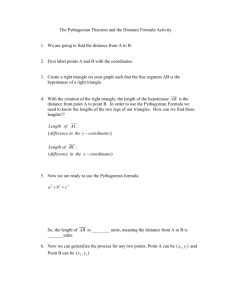
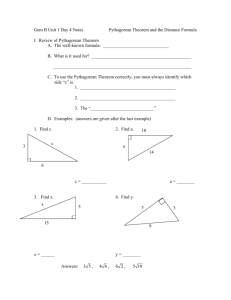
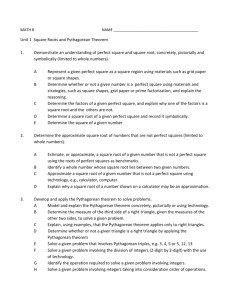
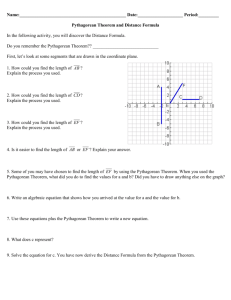
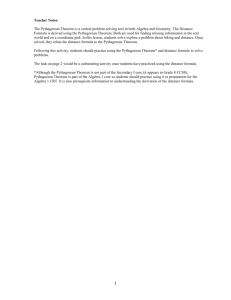
![Pythagorean Theorem Choice Menu]](http://s3.studylib.net/store/data/006637104_1-ef489d42c5b94dc2216093dd08d2b47e-300x300.png)